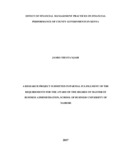| dc.description.abstract | The purpose of the study was to determine the effect of financial management practices on financial performance of County Governments in Kenya. The study used cross sectional research design. The target population for the study was all the 47 County Governments in Kenya. The study used secondary data from County Government financial statements for the year 2015/2016 which was available from the website of the Office of Controller of Budget (OCOB). Population and size per county data was retrieved from the Kenya National Bureau of Statistics (KNBS) and Commission for Revenue Allocation (CRA) websites respectively. Statistical package for social sciences (SPSS) was used for inferential and descriptive statistics data analysis. The dependent variable was financial performance while the independent variables were budgeting, sources of revenue, allocation of financial resources and control of funds. Population per county and size per county were the control variables used in the study. The regression model accounted for 81.5% of financial performance of County Governments in Kenya as represented by the adjusted R2 which was 0.815, essentially means that financial management practices significantly affected financial performance of County Governments in Kenya. The intercept of this model was 0.187. Allocation of resources had the greatest strength on effect on financial performance, followed by control of funds as indicated by the standardized beta of 0.799 and 0.201 respectively. Size of the county and sources of revenue did not have a statistically significant effect on financial performance, since their significance was greater than 0.05. The diagnostics test was carried out for Multicollinearity, auto collinearity and Homogeneity. Durbin Watson statistics was used to test autocorrelation and the statistic was 2.703 which was between zero and four showing there was no auto collinearity. Multicollinearity was tested by Variance Inflation Factor(VIF), all variables had VIF values of less than 10 which shows there was no multicollinearity. Levene test was used to test Homogeneity, the test was not significant at α=0.05 a strong indication that there was no homogeneity which meant that the model could be relied on. The study recommends that Counties should strive to achieve their budgeted revenues since a decrease in actual revenues from the targeted revenue affects the overall financial performance of the counties. Counties should also look at the factors that affect missed revenue targets including creating diverse sources of revenues. Control of funds is also a key area that counties should undertake thoroughly and consistently since it has a significant impact on financial performance. Further counties should consistently strive to expense all their projected expenditures. There should also be a deliberate attempt to allocate more of the funds to development expenditure as opposed to recurrent expenditure. For the financial year 2015/2016 most of the county allocations were 70-90% on recurrent expenditures and prioritization of expenditures. | en_US |



